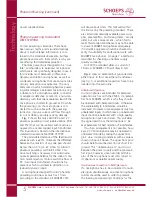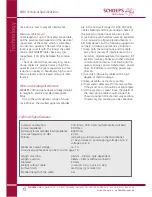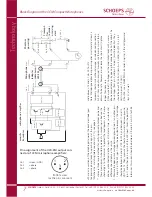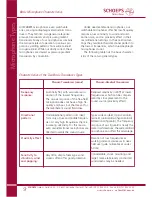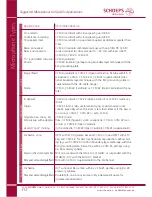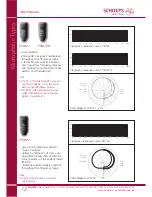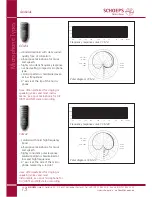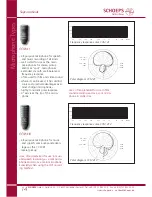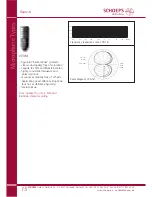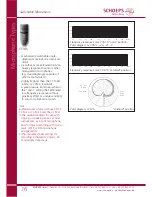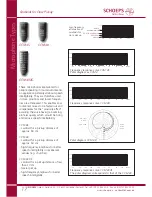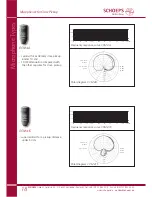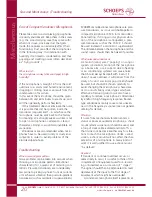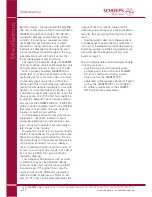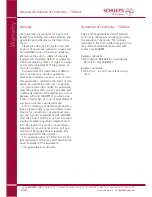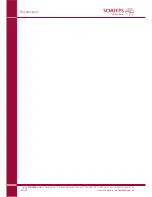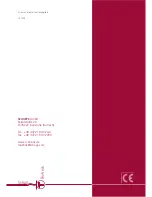
SCHOEPS
GmbH · Spitalstr. 20 · D-76227 Karlsruhe (Durlach) · Tel: +49 (0)721 943 20-0 · Fax: +49 (0)721 943 2050
www.schoeps.de · [email protected]
Acoustical Specifications of Compact Microphones
19
Microphone T
ypes
microphone type
polar
frequency
sensitivity
equivalent noise level
signal-to-noise
max. SPL
pattern
range
CCIR A-weighted
ratio
(0,5%THD)
A-weighted
CCM 2
omni
20 Hz – 20 kHz
16 mV/Pa
23 dB
11 dB
83 dB
130 dB
CCM 2H
omni
20 Hz – 20 kHz
15 mV/Pa
23 dB
11 dB
83 dB
130 dB
CCM 2S
omni
20 Hz – 20 kHz
12 mV/Pa
24 dB
12 dB
82 dB
132 dB
CCM 3
omni
20 Hz – 20 kHz
10 mV/Pa
26 dB
14 dB
80 dB
134 dB
CCM 21
wide cardioid 30 Hz – 20 kHz
13 mV/Pa
24 dB
14 dB
80 dB
132 dB
CCM 21H
wide cardioid
30 Hz – 20 kHz
10 mV/Pa
26 dB
16 dB
78 dB
134 dB
CCM 22
Open Cardioid 40 Hz – 20 kHz
14 mV/Pa
23 dB
14 dB
80 dB
131 dB
CCM 4
cardioid
40 Hz – 20 kHz
13 mV/Pa
24 dB
15 dB
79 dB
132 dB
CCM 4V
cardioid
40 Hz – 20 kHz
13 mV/Pa
24 dB
14 dB
80 dB
132 dB
CCM 41
supercardioid
40 Hz – 20 kHz
14 mV/Pa
24 dB
15 dB
79 dB
132 dB
CCM 41V
supercardioid
40 Hz – 20 kHz
14mV/Pa
23 dB
14 dB
80 dB
132 dB
CCM 8
figure-8
40 Hz – 16 kHz
10 mV/Pa
26 dB
18 dB
76 dB
134 dB
CCM 5
omni
20 Hz – 20 kHz
10 mV/Pa
26 dB
14 dB
80 dB
133 dB
cardioid
40 Hz – 20 kHz
13 mV/Pa
24 dB
15 dB
79 dB
132 dB
CCM 4S
cardioid
80 Hz – 20 kHz
12 mV/Pa
25 dB
15 dB
79 dB
132 dB
CCM 40
cardioid
80 Hz – 20 kHz
18 mV/Pa
22 dB
12 dB
82 dB
129 dB
CCM 4A
cardioid
close pickup
3 mV/Pa
31 dB
19 dB
75 dB
144 dB
CCM 4VXS
cardioid
close pickup
10 mV/Pa
25 dB
14 dB
80 dB
134 dB
CCM 41S
supercardioid
80 Hz – 20 kHz
13 mV/Pa
24 dB
14 dB
80 dB
132 dB
A note about signal-to-noise specifications for
studio microphones. The standard method,
which
SCHOEPS
follows, is really just an alter-
nate way of stating a microphone's equivalent
noise level. It is designed to allow comparison
of noise floor levels for different microphones.
Unlike the signal-to-noise specifications for
other types of audio equipment, which give
the ratio of a component's clipping point to its
noise floor, these values do not indicate a
microphone's entire available dynamic range.
Instead, the values are measured with reference
to a standard sound pressure level of 1 Pascal
(1 Pa = 94 dB SPL). But the actual maximum
SPL capability of any usable microphone exceeds
that reference level substantially. The signal-to-
noise specifications of our microphones would
be 35 to 40 dB greater if the “hi-fi” approach
were used.
The use of “A” weighting when specifying
the equivalent noise level of microphones is
another frequently misunderstood aspect of the
standards. “A” weighting yields a distinctly
lower noise specification – mostly by 10 dB or
more – and this figure, of course, becomes the
one most often cited in advertising. In practice,
however, the CCIR weighted noise level may
well be a more accurate indicator of a micro-
phone's perceived noise level.

